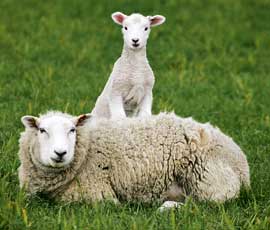Farmers speak out about worrying livestock losses

Farmers have spoken out about worrying levels of lamb and calf losses on their farms.
It follows reports from scanners that they are seeing unusually high numbers of barren animals, failed pregnancies and dead foetuses on some farms this season.
An Oxfordshire beef producer scanned 80 suckler cows two weeks ago and was shocked to discover that 43 were in calf and 37 were empty.
“We’re a closed herd and we have never had this problem before,” he said. “It was painful doing the PDs (pregnancy diagnostic tests) – it felt like having your teeth pulled out with no anaesthetic.”
The farmer is not putting the losses down to poor nutrition as, despite this year’s bad weather, there has been plenty of grass.
“We didn’t start feeding them until the second week of October, because they all had plenty of grass this summer. Whether it’s the wet weather, I don’t know.”
The farm had no positive cases of Schmallenberg last year, but blood tests are due shortly to see whether the disease is to blame, he added.
A Northamptonshire shepherd with a flock of 1,000 ewes said he was “fairly concerned” by the high number of early pregnancy losses.
“We sponged 238 ewes and when we scanned them, 110 were empty, which was a significant proportion.
“We have spoken to farm vets and the sponge manufacturer, but we haven’t been able to find a silver bullet that explains why this is happening.”
Although the flock has been vaccinated against toxoplasmosis, blood tests detected high levels of toxoplasma antibodies, suggesting this could be a contributory factor.
Poor ewe nutrition could also be contributing to pregnancy losses.
“It’s been wet all year and the quality of grass hasn’t been good at all. In general, the ewes just look miserable,” he said.
The Schmallenberg virus did not affect the farm last season. But the shepherd is questioning whether the virus has been hitting his flock this year, although there was no veterinary evidence to support this theory.
“We had none of the classic Schmallenberg cases of deformed lambs last year, but I’m fairly concerned this year.
“We have had one abortion and there could be a continued rumbling of abortions between now and the start of lambing. If we start getting lambs with deformities, we will send them to the AHVLA for tests.”
Dairy farmer Paul Collins, from Helston, west Cornwall, said about 25% of cows were showing pregnancy losses.
“We have had more trouble getting cows in calf than in recent years. I’m putting it down to the weather,” he said.
“It’s a mixed farm, but we have got about 80 cows. They have been out, but we have been feeding them on silage all year and the quality hasn’t been good.
“It’s been wet and muggy and we have lost a lot in previous years through pneumonia. It’s disheartening, but that’s what could be to blame.”
Take part in our lamb and calf loss survey
First 50 farmers respond to cattle and lamb loss survey
